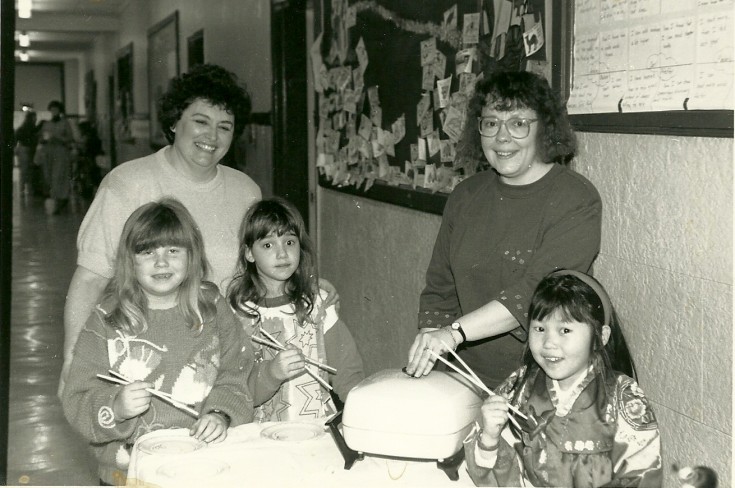
This week's episode of The Sporkful podcast is up! Listen through the player or iTunes/Podcasts app. (And please subscribe!)
Every time you walk into a restaurant, you’re bombarded with signals -- codes that tell you what kind of place it is, and whether it’s for you.
Restaurants put a lot of thought into these codes, which they use to try to attract particular groups of customers.
Some of the signals are obvious -- the food, the décor, the prices. But others are more subtle.
This week on The Sporkful, we're launching a special series on race, culture and food called, Who Is This Restaurant For?
In Part 1, Dan and guest co-host Kat Chow (from NPR's Code Switch podcast) visit three very different restaurants in Washington D.C. to talk to owners and customers about the different messages that are sent in restaurants, how different people perceive these codes, and what these interactions tell us about larger questions of race and culture.
Many of us think of restaurants as places that bring people together for an activity that is universally human: eating.
But former restaurant critic Todd Kliman, who published an article exploring racial coding in restaurants in Oxford American last year, says that's not always true.
"Restaurants have always been about creating us vs. them," Todd says. We like to think that restaurants are places where we bring everyone together – and they can be. But very often...restaurants are exclusionary spaces."
First stop: Sankofa Video Books & Cafe (above), a cafe and bookstore near Howard University.
"We wanted to have a black space," says Tensae Berhanu, who runs the cafe at Sankofa. "It is an intentional endeavor."
In the two decades since it opened, Sankofa's neighborhood has changed, as older black residents have moved out and younger white people have moved in. Not all of the new residents feel comfortable at Sankofa.
"People wanted to be somewhat politically correct [in the comments on a local blog], so they didn’t say that this is a black space but they put it under 'exclusive,'" Tensae says. "Some did say they don’t feel comfortable being here."
Co-owner Shirikiana Gerima questions why that may be:
"Why don’t white people feel comfortable around black people?" she asks. "What is on your mind when you can’t go into a restaurant when there are people who don’t look like you?"
Meanwhile, at Slim's Diner (above) in D.C.'s fast-gentrifying Petworth neighborhood, owner Paul Ruppert says he purposely designed his restaurant, which opened a few months ago, to avoid sending any overt signals to customers -- starting with the name of the place, Slim's.
"That's kind of a traditional nickname that, to me, doesn't have connotations of race, for instance," Paul says, adding that the restaurant is a traditional diner with "no esoteric ingredients [on the menu]."
In fact, when one prospective chef proposed putting duck bacon on the menu, Paul took him out of the running for the job.
"I love duck bacon, but it doesn't belong on the menu at Slim's Diner," Paul says. "It sends the...message...that regular bacon is not good enough and we’re serving fancy bacon."
Last stop: Busboys and Poets (below) -- a bookstore, restaurant/bar, and performance space with six locations around the D.C. area:
Dan and Kat visited the founding location in D.C's U Street Corridor, a neighborhood once known as "Black Broadway" and steeped in African-American history.
When Andy Shallal opened the first Busboys restaurant a decade ago, he purposely designed his restaurant to be welcoming to many different groups of people -- from a huge mural celebrating multicultural leaders (below) to the menu and even his staff.
"In order for a black person to walk into a [restaurant], there have to be signals that say, 'you're welcome,'" Andy says. "What we do here is allow for everybody’s identity to come through -- to feel like they see themselves in this space."
But is Andy's strategy at Busboys akin to pandering? Can you make a restaurant for everybody? And if you could, is that even what people want?
Listen in to the episode to hear the full discussion.
This week's episode of The Sporkful podcast is up! Listen through the player or iTunes/Podcasts app. (And please subscribe!)
Connect with Dan on Twitter, Instagram and Facebook!
Interstitial music in this episode by Black Label Music:
- "Pong" by Kenneth J. Brahmstedt
- "Can You Dig It" by Cullen Fitzpatrick
- "Feel Real Good" by William Van De Crommert
- "Midnight Grind" by Cullen Fitzpatrick
- "Hot Night" by Calvin Dashielle
- "Legend" by Erick Anderson
Photos: FlickrCC/Busboys and Poets PHOTOS; FlickrCC/Dmitry Zuev; courtesy of Sankofa (copyright WUB LLC)







